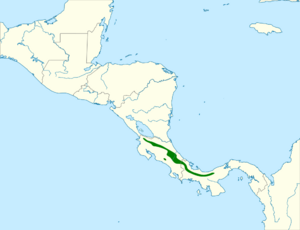Black-breasted wood quail facts for kids
Quick facts for kids Black-breasted wood quail |
|
|---|---|
 |
|
| Conservation status | |
| Scientific classification | |
| Genus: |
Odontophorus (bird)
|
| Species: |
leucolaemus
|
 |
|
The black-breasted wood quail (Odontophorus leucolaemus) is a cool bird that lives in the forests of Costa Rica and Panama. It's part of a bird family called Odontophoridae, which are also known as New World quails. These birds love living in moist, tropical mountain forests.
Contents
What is the Black-breasted Wood Quail?
The black-breasted wood quail is a type of New World quail. It's known for its dark chest feathers. These birds are usually quite shy. They prefer to walk away into the thick forest rather than fly when someone gets close.
Where Does the Name Come From?
The scientific name for this bird is Odontophorus leucolaemus. The first part, Odontophorus, comes from an old Greek word. It means "tooth-bearing," which refers to a small tooth-like bump on their beak.
The second part, leucolaemus, also comes from Greek. Leukos means "white," and laimos means "throat." So, leucolaemus means "white-throated." This is why the bird is sometimes called the white-throated wood quail.
How to Identify a Black-breasted Wood Quail
The black-breasted wood quail is a medium-sized bird. It usually measures about 22 to 25.5 centimeters (8.7 to 10 inches) long.
Males are a little bit heavier than females. Males weigh around 300 grams (10.6 ounces), and females weigh about 286 grams (10.1 ounces). Even though males are bigger, both sexes look very similar. It's hard to tell them apart just by looking.
Where Do Black-breasted Wood Quails Live?
These birds are found in two countries: Costa Rica and Panama. They live in wet, tropical mountain forests.
Sadly, the black-breasted wood quail hasn't been seen in Panama since 1933. This means they might no longer live there. They might be extirpated, which means they have disappeared from that specific area.
How Do Black-breasted Wood Quails Behave?
Black-breasted wood quails are very social birds. They like to stay together in groups all year round. These groups are called coveys. A covey usually has about 10 to 15 birds.
Daily Life of a Covey
These coveys travel together through the forest undergrowth. They search for food throughout the day. When evening comes, they gather to sleep on low branches.
They also work together to protect their home territory. They call back and forth with other coveys nearby. This usually happens right after the sun comes up. They might even act aggressively if another group gets too close to their territory.
What Do They Eat?
Scientists don't know a lot about what black-breasted wood quails eat. They probably eat plants, like seeds or berries. They might also eat insects to add to their diet.
How Do They Raise Their Young?
Not much is known about their breeding habits. However, it's thought that they are usually monogamous. This means one male and one female stay together to raise their chicks.
Sometimes, other adult birds help raise the young. This is called "cooperative breeding." Nesting usually starts when the rainy season begins, around May and June.
Their nests are simple, round hollows in fallen leaves. The entrance of the nest points slightly downwards. Adult birds guard the nests together. Females lay about 4 to 6 eggs. The eggs are white but often get stained brown over time. It takes about 16 to 17 days for the eggs to hatch.



